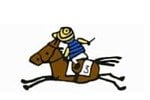Like most horse-mad little girls back in the 1950s, Jenny Pitman’s awareness of the great race dawned when watching the film National Velvet, in which a teenage girl played by the ravishing Elizabeth Taylor has to pretend to be a boy to ride the horse she has saved from the knacker’s yard and trained for Aintree glory – only to have her victory snatched from her when the truth is revealed.
Jenny’s own journey to training fame was almost as difficult and improbable, in the face of male prejudice and constant ill-health; but winning the iconic race became her dream too.
As a young married woman one of Jenny’s most searing memories was of her then husband Richard’s famous defeat in the 1973 running when Crisp, a champion winner at two miles who had led by 25 lengths for some distance after a round of spectacular jumping, was collared on the endless run-in by Red Rum – the first of his three famous victories in this four-and-a-half-mile marathon. The memory long burned in Jenny’s mind.
Jenny Pitman began her training career as a ‘Permit Holder’ with point-to-pointers. She was granted a full licence in 1975, when women were still in a tiny minority in the training ranks, but she quickly aimed for the top.
Her first National runner in 1977, only her second season as a licensed trainer, was The Songwriter, owned by showbiz composer Peter Callander. He was pulled-up following a rough passage, but Jenny had the National bug and The Songwriter ran again in 1979, finishing sixth to Lucius. In 1979 she ran Artistic Prince, who jumped well before falling only four from home, and he ran again in 1982 finishing 12th. In between, Lord Gulliver, who would have had a real chance, had a setback before the race in 1980 leaving Jenny with no runner; he did run in 1981 but fell before completing the race in front but riderless. Her other runner Monty Python failed to complete.
There was therefore little pressure on the Weathercock House team in 1983 with their star staying chaser Corbiere, a bright chestnut with a white blaze. Known in the yard as Corky, a chunky Irish-bred and a ‘stuffy’ sort, he had plenty of racing that season to get him fit, and during a long freeze of the Lambourn gallops he was galloped with the yard’s other two runners Artistic Prince and Monty Python along the beach at Burnham-on-Sea. Corky had won the Welsh Grand National in the mud just after Christmas, and previously come fifth to Bregawn (winner of the subsequent Cheltenham Gold Cup) in November’s Hennessy Gold Cup. He was only eight – considered young for the race in those days – and still in his first season over the bigger obstacles, but at that point the famous Aintree course, sold some years earlier for property development, did finally seem about to close, and however unthinkable, each year in those days it was doubtful there would be another running. Jenny therefore aimed her best stayers at the race year-by-year in a race against time for the coveted trophy.
Corbiere represented her best chance yet, and when the heavens opened the week before the race, Jenny made sure all her family were in attendance: she had a gut feeling that history would be made. On the day, carrying 11st 4lbs (high enough for a novice), and piloted by Ben de Haan, Corbiere jumped like a stag barely touching a twig around the entire two circuits of the daunting course, which was much stiffer at that period before a few ditches were filled in and fences lowered. His luck held: no loose horse or faller balked his progress, and he came home in bright sunshine just in front of the more experienced Greasepaint – who had almost caught him with a late rally, forcing ‘Corky’ to pull out every stop in a final lung-bursting surge for the line. Several Grand National specialists like 1982 winner Grittar, Delmoss and Spartan Missile were strung out behind.
The crowd and the press went wild. “Mrs P” had succeeded in her lifetime ambition, simultaneously becoming the first woman to train a Grand National winner, and everyone wanted a piece of her: dragged away from owners, family and friends, as she later said “I’d become public property”. On the way home, a service station cashier recognised her – “It was the first inkling that winning the Grand National might change my life” she remarked.
Jenny’s win also may have changed the fate of the famous race. The very real threat to the course since owner Mirabel Topham’s 1973 sale to property developer Bill Davies now seemed at last to be imminent, as he announced its closure, the race was even bigger news than usual, and a woman trainer winning was a golden gift to a hungry media. Jenny’s coronation as ‘First Lady of Aintree’ started in the wake of Corbiere’s victory, and she was asked to speak at the Savoy’s luncheon for ‘Women of the Year’, appeared on ‘This is Your Life’ and signed a book contract.
Corbiere went on to run in the race four more times, finishing a gallant third under a stopping weight in both 1984 and 1985, suffering a rare fall in 1986 and completing an honourable 12th at the age of 12, in what was his final race. He remained in the yard as a schoolmaster to young horses and jockeys, docilely greeting coachloads of disabled visitors to the yard, and meanwhile becoming a media celebrity almost as well-known as Red Rum. Enjoying his fame and its attendant outings every bit as much as ‘Rummy’, Jenny recounted: “He used to come on stage like a rock star, rearing and leaping around as if to say, Look at me!”
With his trainer, ‘Corky’ attended numerous events that spring and summer for the ‘Save the Grand National Appeal’ and, like ‘Ginger’ and Red Rum, both did their considerable bit raising large sums so that in 1983 Aintree could be bought by the Jockey Club for the nation. The racing public owes a huge debt to Jenny, as well as to Corbiere and his owners for helping to raise the required sums.
The following year Jenny notched up another memorable record as ‘first lady‘, being the first of her sex to train the winner of the Cheltenham Gold Cup with the fragile Burrough Hill Lad – a wonderful feat of skill with any horse, let alone one so hard to keep sound as him. Meanwhile the Pitman “love–hate relationship” with the most demanding of races carried on unabated.
In 1991 Jenny’s latest stable star Garrison Savannah won her another Cheltenham Gold Cup, piloted by her son Mark. ‘Gary’ was also entered for the Grand National three weeks later, but in the Country Hurdle Mark later that day fell and broke his pelvis. Jenny then had the hopeless task of dissuading her son from any thought of riding the horse at Aintree – and to compound her problem the horse too became marginally unsound! Although the yard had three other runners, the medics and physios worked non-stop on both horse and rider, and in the event they very nearly pulled off the elusive double. Still in the lead at the last Mark and ‘Gary’ were to be overhauled on the run-in by Seagram in a ghastly repeat of Richard’s defeat on Crisp so long before. Jenny however, who said she felt she had “more like broken glass than butterflies in my stomach before the race” was just thrilled they had got back in one piece.
Most people remember that Jenny also won the race in 1995 with Royal Athlete, making her the only woman trainer so far to have a Grand National double. Younger fans tend to forget that it was so nearly a treble. As she wrote in her gripping autobiography: “The Grand National has at times stretched my emotions to breaking point… But nothing prepared me for the dramatic events that led to the 1993 race being declared void after a monumental cock-up.”
That year with three good runners – Garrison Savannah again, Esha Ness and Royal Athlete – Jenny had high hopes; but a couple of muddled false starts (partly due to the antics of animal rights activists and partly due to a faulty tape) which a flagman failed to observe led to the biggest disaster in the history of the race. The ensuing ten minutes were chaotic. Due to the demonstrations several jockeys mistook efforts to stop them, many raced for a circuit before pulling up, and seven completed the course, led past the post by one of Jenny’s runners Esha Ness in 9min 1sec, the second fastest time ever recorded. Trying to find an official she caught sight on the Weighing Room TV of her horse crossing the finishing line, “but I knew of course that the result would not stand. With that I broke down sobbing… I sat there for a long time in a state of total shock and disbelief.”
Jenny was obliged to ask Aintree for help with the media in the aftermath of the race, and several course officials no doubt felt the famous rough edge of the Pitman tongue. In 1995, however, the intrepid trainer was back for more, and entered no fewer than six of her charges in the National: the three stalwarts from 1993 all now 12, and three younger horses. Royal Athlete’s leg problems had been well publicised and he could be backed at 50/1 on the morning of the race. Told by Jenny to “ride him as if his reins were threads of cotton” his young jockey Jason Titley gave ‘Alfie’ the perfect ride and won at his first attempt, the horse coming back without a scratch.
By this stage Jenny had won two Grand Nationals, three Welsh Grand Nationals, and two Midlands Grand Nationals. That year she took Willsford to Ayr and added the Scottish Grand National, making a Grand Slam of all four UK races. In 1997 she hit the headlines again, finally adding the Irish Grand National run at Fairyhouse to her personal Roll of Honour, with Mudahim shading the Irish horse Amble Speedy in a tense photo-finish. Winning all the five ‘Nationals’ was a feat only the ultra-competitive and perennial Champion Trainer Martin Pipe had ever pulled off before.
With two good chances, Smith’s Band and Nahthen Lad, again entered in the Aintree race that year, Jenny conducted her by-now-traditional bantering interview with Des Lynam, before the devastating IRA bomb scare which demanded the evacuation of the course just before the race. Threatened with arrest, she was forced to leave her horses with all the others in the racecourse stables. Busy over the weekend with endless media interviews, she didn’t know at the time that the IRA had also made a threatening call to the yard, saying they were ’watching her’. Unfortunately she felt her horses had gone off the boil by the time the race was run on Monday, and Smith’s Band sadly dropped dead at the twentieth fence, possibly of a heart attack; who knows if the stress Saturday’s events contributed? Racehorses are sensitive creatures. Nahthen Lad and Jason Titley finished ninth.
Jenny observed “Somehow whenever there was a drama at Aintree, I seemed to have a front row seat… I sometimes wondered why I kept going back. But deep down I knew why. Aintree was addictive.”
There was yet more drama in 1998, when Nahthen Lad was her only runner. Following a lot of rain, deep holes in the course were not properly filled in following Friday’s races, and the trainer was scandalised by the state of the ground when she walked the course. Employing Naval language, she rang the Clerk of the Course to tell him what she thought. When he demurred she told him “Look Ian, don’t bullshit me. I was walking this course when you were still in your cradle” – the Pitman reputation for feisty plain speaking wasn’t earned for nothing!
Not wanting to cause a media furore, she nevertheless decided to run but make sure Nahthen Lad was taken wide, and was quite relieved when he unseated on the first circuit and ran safely back to the racecourse stables! There was an unpleasant aftermath, when Jenny’s pointed letter to the powers that be was leaked to the press; as she put it “there was no doubt in my mind that some old school tie pressure was being brought to bear.” A subsequent meeting in May 1998 however did bring about improvement in ground-staff numbers, Jenny’s long and loyal support for the great spectacle adding weight to her words. Other suggestions she made then to improve the safety of the race for horses and riders have also been taken on board.
In 1998 Jenny’s services were recognised when the Queen conferred on her the OBE. By now ill-health was catching up with the seemingly indestructible trainer, and following a bout of cancer she announced her impending retirement to a shocked media and public at the 1999 Cheltenham Festival. Her final runner in the Grand National that season (of 39 in all) was therefore Nahthen Lad, who again ran and jumped well and even led for a while, coming back a respectable 11th and mercifully safe and sound. Des Lynam duly kissed a bittersweet Jenny on behalf of a grateful nation, before she bowed out in fine style, by winning the closing Bumper with King Of The Castle, a victory which was cheered to the rafters by fellow professionals and her adoring fans alike.
By Sara Waterson
Allison is the Publisher of Eclipse Magazine. She loves going to the Races and is learning to bet (despite being officially the worst bettor in the History of the Universe), there’s a lot more to learn…






